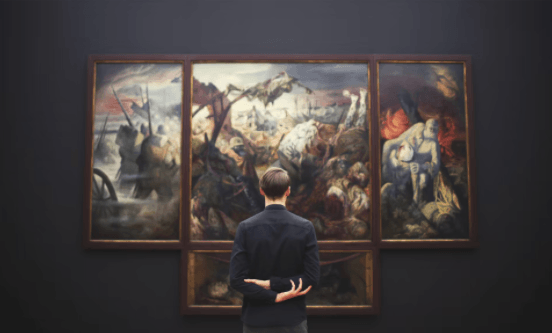
Art Decoded: Hidden Meaning in These Famous Paintings
Have you ever stared at artwork with awe and wonder? What the painter was thinking about during the creative process, what prompted him to paint in the first place, his inspiration, motivation, and if there are meanings that are not visible at first glance.
If there is something we are aware of as artists, it is that art is not easily understood, especially if you don’t stare at it long enough or conduct enough research about the artist’s life, the period he lived in, etc. Perhaps one of the wonderful aspects of artworks is that they are always subject to different interpretations.
You can spend hours gazing at your favorite artwork and yet uncover a new cryptic sign or hidden feature along with the image. For years, certain paintings have captivated art enthusiasts not just because they are beautiful, but also because they contain unresolved riddles and hidden truths.
The more that we stare at an artwork, the more we realize that there is so much more to the painting than the actual depiction itself, making us realize that the artists were indeed brilliant. It turns out that artists like da Vinci, Raphael, Michelangelo, Van Gogh, and their contemporaries were even more clever than we previously thought. Join us as we decode and crack the hidden meaning in these famous paintings. Keep on reading if you wanna learn more!

There is always more to a painting than meets the human eye, and many of the world's most beloved pieces of art have riddles to be solved beneath the surface. There's a reason why famous works of art have sparked plenty of conspiracy theories and mystery narratives.
We may not be able to ask the painters about the real and intended meaning for those pieces, as well as the hidden messages they encrypted along, so our imaginations go wild while decoding the hidden meanings and symbolism.
While these intriguing, occasionally controversial nuances in well-known pieces of art aren't as cryptic as the famous Da Vinci Code series, they may cause you to reconsider the way you perceive these paintings differently.
Uncover the Hidden Meaning in These Famous Paintings
They say that some mysteries are meant to be left unsolved but such is not the case in most situations. While many conspiracy suggestions concerning the true meaning or alternative meanings have been rejected and labeled as mere speculative thoughts, let us reveal the hidden meaning in these famous paintings that will shock you. After reading this, you will most likely look at these paintings in a different light.
1. The School of Athens by Raphael, c. 1509-1511:
This painting is a depiction of all the greatest philosophers, scholars, scientists, and mathematicians during classical antiquity as if they are coming together to share ideas and learn from one another in one place and time.
These figures all lived in various eras, yet they are all grouped in the same moment. This painting features thinkers like Aristotle, Socrates, Plato, Epicurus, Averroes, Pythagoras, and plenty more. While it is hard to identify which is which, experts have noted that we can distinguish and identify the thinkers in the painting through the poses that they depict based on their field of study or central ideology.
For instance, the central figures, are Aristotle and Plato. You may have noticed that the two philosophers are making some peculiar hand gestures. These are said to be their responses to the philosophical question, "Where does genuine knowledge reside?" "Plato is pointing upwards, representing abstract knowledge whereas Aristotle is pointing with his hand to the ground, representing empirical knowledge.

2. The Last Supper by Leonardo da Vinci, c. 1495–1498:
Of course, this list wouldn’t be complete without this painting. This painting is not only famous for its impressive use of perspective, composition, and tones, but also the plenty of theories surrounding the mystery of the “holy grail.” Perhaps this is one of the most discussed pieces every time we create a “hidden meaning in these famous paintings'' list.
The renowned depiction of Jesus and his followers in this famous painting by da Vinci has been at the center of various popular beliefs in recent years, as shown in the novel "The Da Vinci Code" written by Dan Brown in 2003 and the 2006 film adaptation of the same name. In the book, Brown theorized that the follower to Jesus' right is Mary Magdalene instead of John the Apostle, as believed by many.
He further claims that the "V" formed by Jesus and "John" depicts a female womb, implying that Jesus and Magdalene had a child together.
On another side of the story, Giovanni Maria Pala, an Italian specialist, discovered a much more interesting hidden message. He says that Da Vinci buried musical notes within the painting that match a 40-second song that sounds like a requiem.

3. The Last Judgment by Michelangelo, c. 1535-1541:
This painting depicts one of the most famous biblical scenes in the New Testament, which is the second coming of Jesus Christ and God's eternal retribution and final judgment of all humanity.
The scene portrays the rise of the dead and their descent to their respective destiny, as assessed by Christ, who is surrounded by different saints. If you look closely at the detail, you would notice a self-portrait of the artist, which can be seen in the flayed skin carried by St. Bartholomew, who was one of the disciples of Jesus.
It is evident in almost all of his paintings that Michelangelo was a religious person but that didn’t stop him from questioning the teachings of the Catholic church, which was condemned by the Pope. Accordingly, this painting was regarded by Pope Paul IV as a form of defamation of the church as it implied that Jesus and others around him talked with God directly without the necessity of the Church. The painting was originally full of nude figures but was eventually covered.

4. The Starry Night by Vincent Van Gogh, c. 1889:
This painting, regarded as the artist’s magnum opus and one of the greatest and most popular paintings in the world, also has hidden meanings on the surface. Many analysts believe that the twisted cypress tree in the backdrop is associated with death and Van Gogh's final suicide.
The tree in the artwork stretches towards the sky, creating a direct link between the ground and the skies. This hopeful view of cypress symbolism recalls the artist's letter to his brother, Theo, in which he compared death to a train that journeys to the stars.
Another meaning to the painting was given by Jose Luis Aragon, a physicist, who connected the tumultuous dance of light and dark in the painting to the mathematical description of disturbance in natural phenomena such as air streams and whirlpools. He discovered that they were nearly identical.

We may never really know if the artists intended to have these paintings be interpreted in the way that we interpret them presently, but it is always fun to perceive these artworks in multiple ways.
We believe that there is so much more than meets the eye and that there is always more than just one way of looking at things. We hope that you enjoy this unveiling of hidden meaning in these famous paintings. Do you want us to make a part two about this topic? Let us know and tell us which paintings you want to learn more about!





